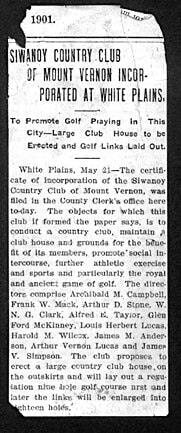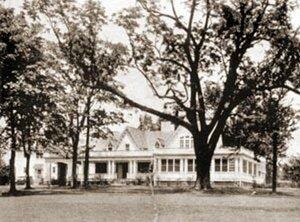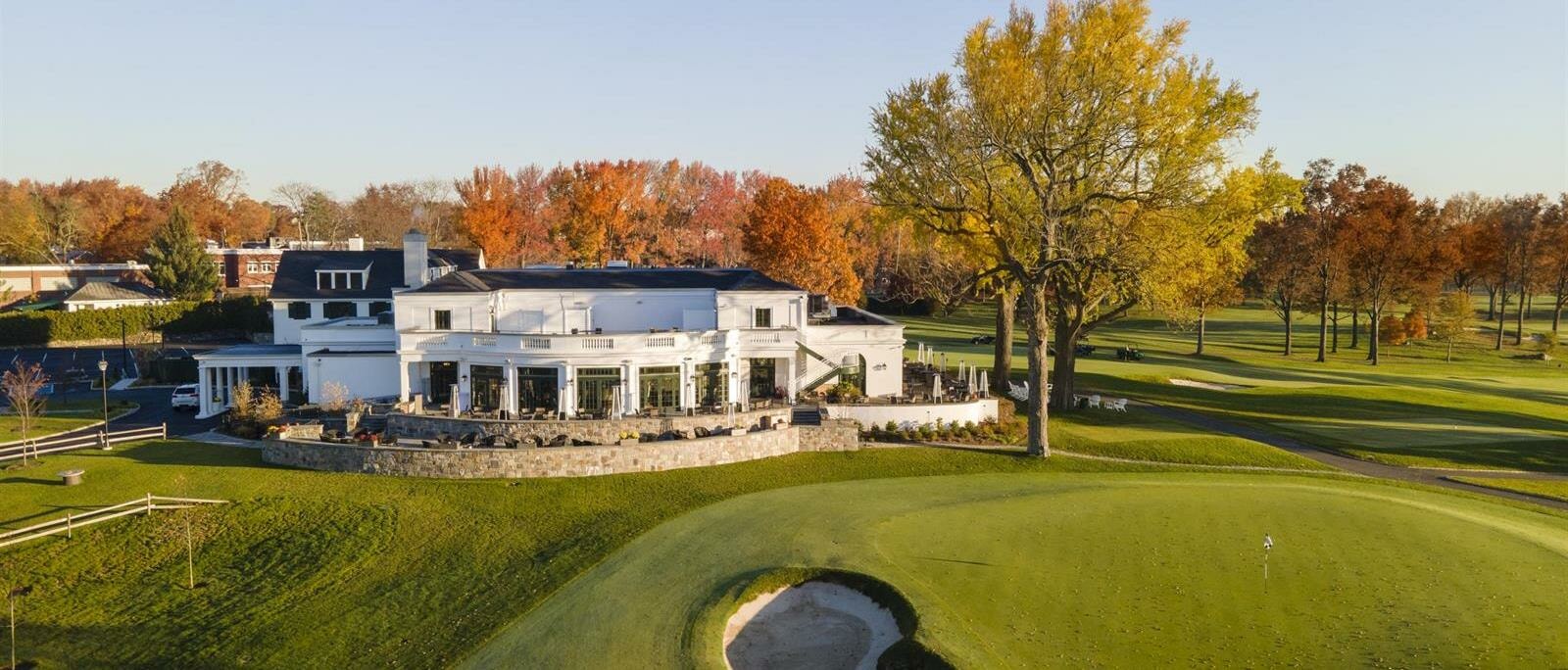As is so often the case, a record of the history of the origin of Siwanoy Country Club is based on a mixture of legend and facts.
The Origin - The Legend

About the year 1900 there was a small but enthusiastic group of gentlemen golfers, principally residents of Mount Vernon, who traveled by trolley car from their homes to play on a small “improved nine hole golf course” located on the southern outskirts of the Village of Tuckahoe. As far as can be determined, this improvised course was located on the property of the Rose brothers, who were then developing that section of the Village of Tuckahoe or Town of Eastchester located just a little north of the present Club property. The members of this original group rented a room in an existing house on Rose Avenue, for use as their locker room. They also became increasingly annoyed, as golfers might, about the infrequent service rendered by the trolley between their golf course on the outskirts of Tuckahoe and their homes in Mount Vernon.
One evening in the late fall of 1900, while the members of this original group were sitting on the porch of their Rose Avenue locker house, “cooling off” in the traditional manner of all golfers and contemplating the long trolley ride home, the idea of establishing a golf course much closer to their homes in Mount Vernon, surfaced and was enthusiastically endorsed by those present with their glasses held high. After a brief but “spirited” discussion, possible use of the “Glover Estate”, much closer to their homes in Mount Vermont, for a new location of their golf course was approved by strong and loud affirmative votes.
Ordinarily, authors do not like to disclose all of the sources of their material. However, the legend of the origin of Siwanoy is of such importance that the author of this history will merely furnish a quotation from a prepared address given at the Club’s Twenty-Fifth Anniversary in 1926:
“Mr. Schmuck tells me that he and a number of other gentlemen, before the Club was organized, used to play on a small nine hole golf course in Tuckahoe, just a little north of the Club here, the property of the Rose brothers who were developing the section. They rented a room on Rose Avenue and had lockers there. They used to get to the course by means of a one horse trolley car, and in cold weather used to take turns at firing the coal stove in the car to keep warm. It was a journey in those days from Mount Vernon to Tuckahoe. While on the porch of one of these men, the idea of getting a place nearer home, and the possibility of obtaining the use of the Glover Estate, located on the outskirts of the City of Mount Vernon, suggested itself and steps were taken for a Club.”
Mr. Schmuck was one of the original members of Siwanoy Country Club. The words from this above quotation, “a one horse trolley” are to be noted. This expression could have two meanings – a trolley drawn by one horse or an inadequate, second rate electric trolley. Information supplied by some of those who actually rode on this White Plains Road trolley establish that it was not horse drawn and that Mr. Schmuck’s words must have the second meaning. The conveyance may indeed have been a “Toonerville trolley” in most respects.
Legends that are often repeated or set in print sometimes draw forth comments and bring forth new evidence that changes the legends into facts. Perhaps this is just what has happened to our legend of the Origin of Siwanoy. Mrs. Anita Comstock, the wife of one of the Club’s members and a recognized Bronxville historian, has located two of the daughters of one of the Rose brothers referred to by Mr. Schmuck and previously mentioned in this history. One daughter, Mrs. Nan Rose Howe, now residing in California, has recently written Mrs. Comstock several most interesting letters. In these letters Mrs. Howe gives her recollections and those of her sister regarding the development of the Rose brothers’ property and of the origin of Siwanoy Country Club. It is interesting to see how Mrs. Howe’s recollections and those of her sister tie in with Mr. Schmuck’s, and the Legend of the Origin of Siwanoy set forth herein. What follows is a condensation of Mrs. Howe’s recollections as recorded in her recent letters to Mrs. Comstock.
Before 1897 there was a race track for sulky races located east of White Plains Road and south of the property acquired by the Rose brothers. This track may have been located, at least in part on the present Siwanoy golf course property. The race track was not in use much after 1897. The Rose brothers, Mrs. Howe’s father, Augustus Thayer Rose, and his brother, Middleton Rose, after coming over from Yonkers to go to the sulky races, became interested in a tract of land near the race track. Middleton Rose became so interested that in about 1897 he bought a large section of land in the area north of the race track called Fairview Park, for development purposes. There was only one large house on this property at this time. This house faced on Rose Avenue, had beautiful trees around it and a large apple orchard in the back towards the Siwanoy property. This original house is still standing at the southeast corner of Rose Avenue and Ridge Street. Mrs. Howe’s father and mother first moved into this house and then in 1900 moved into a new but smaller house at the end of Rose Avenue. Middleton Rose built a house nearby.
Middleton Rose between 1897 and 1900 laid out a small 9 hole golf course on the Fairview Park property, which golf course was subsequently called the “Fairview Country Club.” This is undoubtedly the 9 hole golf course to which Mr. Schmuck referred. Mrs. Howe even reports that there were two or three good clay tennis courts back of the original Fairview Club House.
Mrs. Howe and her sister knew well the trolley on White Plains Road as she, her sister and her family used it frequently in going to church in Mount Vernon and attending frequent activities in that city. The suitors of Mrs. Howe and her sister often had “to dash to catch the last trolley home.” Neither Mrs. Howe nor her sister recall that the trolley was ever horse drawn.
The present Siwanoy property in Mrs. Howe’s day was commonly, but erroneously, called “Paulding Manor.” She recalls the property as having a big rambling house, with several outbuildings, large stables and a tenant house to the west of the big house. A family named Fox was living in the big house when Mrs. Howe’s older sister and her father and mother first moved into Fairview Park. The smaller tenant house was occupied by the caretaker named Cotton and his wife. After the Foxes moved out of the main house no one occupied this manor house until the property was acquired by Siwanoy Country Club in 1913. How much of our legend of the origin of Siwanoy has now become facts!
The Origin – The Facts
 In the latter part of 1900, the idea of forming a golf and country club originated with a small group of about 18 men golfers when it became generally known that there was a possibility of procuring the “Glover Estate, Corcoran Manor” property for creating a golf course. The “Glover Estate” property was located along White Plains Road at about Columbus and Lincoln Avenues in the northern part of the City of Mount Vernon and was later known as “Bailey Park.” A lease of this Glover property was procured by this group and steps were taken immediately to organize and incorporate a golfing country club. The old Glover Mansion was converted into a Club house.
In the latter part of 1900, the idea of forming a golf and country club originated with a small group of about 18 men golfers when it became generally known that there was a possibility of procuring the “Glover Estate, Corcoran Manor” property for creating a golf course. The “Glover Estate” property was located along White Plains Road at about Columbus and Lincoln Avenues in the northern part of the City of Mount Vernon and was later known as “Bailey Park.” A lease of this Glover property was procured by this group and steps were taken immediately to organize and incorporate a golfing country club. The old Glover Mansion was converted into a Club house. The name “Siwanoy” was adopted after long consideration. It was reported to be the Indian name of a Mohican tribe or family which had inhabited the lands near and along the shore of Long Island Sound approximately from New Rochelle to Hell’s Gate in the Bronx.
The papers of incorporation setting forth the name of the new membership corporation as the “Siwanoy Country Club of Mount Vernon” were duly filed and recorded in the office of the County Clerk of Westchester County on May 20, 1901. On that date our Siwanoy was born. The name of the Club remained unchanged until the fall of 1946 when the name was officially changed to “Siwanoy Country Club.”
Originally after solicitation, 107 men signed an agreement to pay a ten dollar initiation fee and twenty five dollars annual dues to the new golf and country club. Within a short time the number of gentlemen who signed the membership roll, and thus became charter members, had increased to about 150.
The purposes of the original Siwanoy Club were “to conduct a country club, maintain a club house and grounds for the benefit of its members, promote social intercourse, further athletic exercise and sports and particularly the royal and ancient game of golf.” These are the same objects of the club as stated in Article I of the Constitution under which we operate today, except that for some unknown reason in years past, the adjectives “royal and ancient” were stricken from the last phrase of the purpose clause.
A newspaper article on May 22, 1901 , two days after its formal incorporation, stated that work on the grounds along White Plains Road had been started and that the golf links would soon be ready for golfers.
On July 4, 1901 Siwanoy Country Club had its formal opening. A number of tennis courts were completed and ready for play by the end of July 1901. The nine hole golf course was ready for play in the fall of 1901. A croquet grounds was also provided, as well as ping-pong tables in the club house, The cost of “preparing,” the nine hole golf course and tennis courts, together with their maintenance charges for the first year, was about $2,500.
The Club membership toward the end of its first year, included 172 regular members, 18 junior members, 1 non-resident and 77 associate members.
The First Board of Governors even evidenced a kindly disposition towards the ladies of the Club. Before the first year of Siwanoy’s existence came to a close, it was reported that the Board had instructed the House Committee to permit the ladies to use the ping-pong facilities without charge during the day time, except on Saturdays, Sundays and holidays.
In the spring of 1903, the members of the Club were notified by the owners of the Glover property that the Club’s lease would be terminated, as the property was going to be sold to a Mr. Bailey who owned a circus. Fortunately, the Club was able to lease another tract of land, the “Hunt Property,” located in Mount Vermont but further north than the original club house site. Again, a nine hole golf course and a modest club house were constructed on this Hunt property, along with tennis courts. About $6,000 was raised by subscription from members and used for constructing these facilities. The Cross County Parkway now traverses the Hunt Property and much of this property has long since given way to real estate development. Siwanoy Country Club existed on the leased Hunt property for about ten years, from 1904 until 1914. In those ten years Siwanoy was growing rapidly in membership.
By 1913 the increasing membership made the nine hole course on the leased Hunt property inadequate. It was decided that the construction of an 18 hole golf course was necessary. This, along with the fact that the club house and golf course were on leased land gave rise to the thought of purchasing the Hunt property and some adjacent vacant land, or purchasing a larger tract of land still further north on which an eighteen hole golf course and a larger club house could be constructed. Apparently, the problem of where to locate the new eighteen hole golf course was solved by Mr. Donald Ross, a well known golf course architect. who had been retained to layout and supervise the construction of a new eighteen hole golf course. After examining the Hunt and adjacent property. Mr. Ross apparently rendered an adverse report on locating the new golf course on this Hunt property.
After a further search and a careful study, suitable acreage was found in the town of Eastchester, adjacent to the Village of Bronxville. The purchase of this property was enthusiastically supported by the members. This tract consisted of about 110 to 114 acres of farmland then commonly but mistakenly known as the “Paulding Manor Property.” It lay just south of the property of the Rose brothers. Local tradition had it that this land had been given to a John Paulding by a grateful Continental Congress for his part in the capture of the unfortunate British military spy, Major Andre, during the Revolutionary War. Contrary to the legend, Historians have established that the Manor Property was not given by the Continental Congress to John Paulding but to David Williams, who was another member of the patrol of three Continental soldiers (Paulding, Williams and Van Wart) that captured Major Andre. This Manor Property is the land now occupied by the present Siwanoy Club House and Golf Course.
The purchase of the Manor Property was accomplished through the formation of the “Siwanoy Country Club Realty Corporation,” consisting mainly of Club members, as the owner. The Club was in possession under a lease from the Realty Corporation.
Old records indicate that the property was purchased from the Westchester-Bronxville Realty Corporation, which continued to hold a second mortgage on the property, after its purchase by the Siwanoy Country Club Realty Corporation.
In the fall of 2020 Siwanoy County Club completed a 38,000 square-foot clubhouse renovation and expansion project which included two substantial additions and major infrastructure enhancements to the original structure, which was built in 1893. The entire facility underwent a dramatic re-design, finished with high-end materials, and was completed on schedule and under budget.
The Club's expansions included new dining facilities, a rooftop terrace, a dining patio, a grill room, and a formal banquet hall, all of which allow the Club to comfortably accommodate over 500 guests. The dining facilities were outfitted with three new bars and 2,500 square-foot kitchen, designed to host multiple functions simultaneously.
Hospitality areas were also renovated and expanded to include six private "hotel" suites on the third floor, a wine cellar, and heritage room, designed to pay tribute to the Club's historical significance. Both women's and two-story men's full-service locker rooms were constructed, each with terraces that overlook the golf course.
Click here to view an overview of the complete project.
